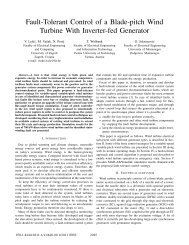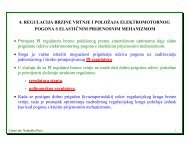Damping of Wind Turbine Tower Oscillations through Rotor Speed ...
Damping of Wind Turbine Tower Oscillations through Rotor Speed ...
Damping of Wind Turbine Tower Oscillations through Rotor Speed ...
Create successful ePaper yourself
Turn your PDF publications into a flip-book with our unique Google optimized e-Paper software.
The borderline between two operation<br />
regions is the lowest wind speed at which<br />
turbine generator reaches its rated power<br />
output. This wind speed is termed rated wind<br />
speed [1]. Hence the wind turbine operation<br />
regions are known as below and above rated<br />
regions. In this paper we focus on the above<br />
rated operation region and describe design <strong>of</strong><br />
controllers used in that region.<br />
The paper is organized as follows. Section 2<br />
gives a general description <strong>of</strong> the wind turbine<br />
control system. Section 3 introduces<br />
mathematical model <strong>of</strong> the wind turbine that is<br />
used for controller design. Section 4 describes<br />
the design <strong>of</strong> PID controller which is nowadays<br />
standard solution for wind turbine control. In<br />
section 5 and 6 two alternative control concepts<br />
are proposed and their performances are<br />
compared with the performance <strong>of</strong> PID<br />
controller. Conclusions are given in section 7.<br />
2. <strong>Wind</strong> turbine control system<br />
The main task <strong>of</strong> wind turbine control system<br />
is to obtain continuous power production under<br />
operating conditions determined by various<br />
wind speeds. As turbine power is directly<br />
proportional to its speed, power control can be<br />
done by controlling turbine speed. The<br />
principle scheme <strong>of</strong> wind turbine speed control<br />
system is shown in fig. 1. As it can be seen in<br />
this figure turbine speed can be influenced and<br />
Figure 1: Principle scheme <strong>of</strong> wind turbine control<br />
system.<br />
thus controlled by two means – by generator<br />
electromagnetic torque Mg which opposes rotor<br />
driving torque Mr and by pitch angle β which<br />
alters the wind energy conversion. For this<br />
reason turbine speed control system consists <strong>of</strong><br />
two control loops: torque control loop and pitch<br />
control loop. Those control loops operate<br />
simultaneously but depending on operation<br />
region one <strong>of</strong> them is dominant. In the below<br />
rated operation region the torque control loop is<br />
used to control turbine speed to values that will<br />
result in maximal wind power capture. This<br />
control loop is not in the scope <strong>of</strong> this paper.<br />
Details on its specifics can be found in e.g. [2].<br />
In the above rated region this control loop just<br />
holds generator torque at its rated value.<br />
The pitch control loop is used for setting the<br />
adequate pitch angle that will keep turbine<br />
speed at its reference value under all operating<br />
conditions determined by various winds. Below<br />
rated wind speed this loop sets pitch angle to<br />
value that assures maximal wind power capture<br />
which is usually around 0 o . In this paper we<br />
assume that all blades have the same pitch<br />
angle what is known as "collective pitch".<br />
Controller in this loop, although used to control<br />
turbine speed, is commonly termed pitch<br />
controller. Blade positioning is mostly done<br />
using electrical servo drives that rotate blades<br />
by means <strong>of</strong> gearboxes and slewing rings.<br />
Position control <strong>of</strong> servo drives is usually<br />
achieved using frequency converters. This<br />
control loop design is rather simple and is not<br />
in the scope <strong>of</strong> the paper. For simulation<br />
analysis it is modeled as second order system:<br />
SD<br />
( )<br />
G s<br />
( s)<br />
( )<br />
β<br />
ω<br />
= =<br />
β ζω ω<br />
ref s<br />
2<br />
s + 2 β<br />
2<br />
nβ<br />
nβs+ 2<br />
nβ<br />
. (2)<br />
In this paper we use ω nβ =6.28 rad/s and<br />
ζ β = 2/2 what is fairly good approximation<br />
<strong>of</strong> real pitch positioning system.<br />
3. <strong>Wind</strong> turbine model<br />
The first step in control system design is<br />
construction <strong>of</strong> a suitable process model for<br />
wind turbine in scope. <strong>Wind</strong> energy<br />
conversion process is highly nonlinear and<br />
difficult for mathematical description. It can be<br />
described quite well using combined blade<br />
element and momentum theory [1]. However<br />
this approach yields implicit mathematical<br />
expressions that can only be solved iteratively.<br />
This form, although very common in<br />
simulation tools, is not suitable for controller<br />
design. So in this paper we use another<br />
somewhat simplified mathematical model that<br />
is usual in the literature dealing with controller<br />
design. Here we describe it briefly, while<br />
details on it can be found in [3] and [4].<br />
Power contained in wind given by<br />
expression (1) can never be completely<br />
transformed into wind turbine power and<br />
afterwards into electrical power. The amount <strong>of</strong><br />
wind power that is converted into turbine<br />
power Pr can be described by means <strong>of</strong><br />
performance coefficient CP [1]:







